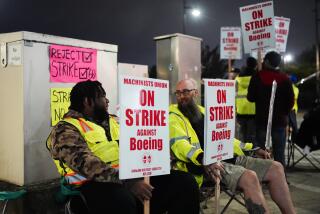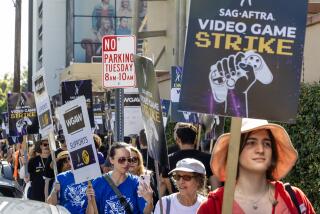Hints of Some Progress in GM-UAW Standoff
DETROIT â Entering the holiday weekend, negotiators for General Motors Corp. and the United Auto Workers appeared to be stepping up efforts to settle the costly and disruptive strikes that have shut down GMâs production.
Publicly the two sides have kept up their confrontational rhetoric. The official line is that no progress is being made and the walkouts--entering their fifth week today--could last well into August.
But there are also subtle signs of movement toward an agreement behind the scenes, including the involvement of senior negotiators in the talks and a moderation of threatened actions by both sides.
Labor Secretary Alexis Herman told reporters Thursday in Washington that she talked with both parties this week. While declining to speculate on when a settlement might come, she said it was a good sign that talks have continued on a daily basis since the first strike began June 5.
âIâm encouraged by the fact that they are still at the table,â Herman said.
The pressure is growing for a settlement by July 13, when GMâs normal two-week summer shutdown ends and its assembly plants are scheduled to restart operations. An agreement by then would lessen GMâs production losses, which already have totaled 227,000 vehicles.
Some analysts expect a deal by Monday. That would mean laid-off workers would not lose a weekâs vacation pay. The pay also could be restored in a later agreement, but analysts said that would be difficult for GM to justify to Wall Street after sustaining strike losses of $1.2 billion.
âThe next three days provides a good window of opportunity to settle this,â said Maryann Keller, analyst for Furman Selz.
The strikes by 9,200 workers at two parts plants in Flint, Mich., were prompted by UAW concerns for jobs and GMâs push for greater plant efficiency. Though the battle is ostensibly over local issues, it has evolved into a broad debate about global competitiveness and export of U.S. jobs.
The strikes have had a domino effect on GMâs operations. As the flow of parts dried up, the nationâs No. 1 auto maker was forced to close more than two dozen assembly plants and lay off 163,000 hourly employees.
Besides crimping earnings, GM said the strikes could devastate sales and market share. It said a long strike will prompt thousands of customers to buy cars from rivals, including foreign manufacturers who run nonunion shops.
In an effort to pressure the UAW, GM has hinted that it could close some plants and eliminate low-profit cars. GM also filed a grievance against the union, alleging that the strikes are illegal since they are over issues outside the local contract, and asking an arbiter to assess the UAW for strike-related losses.
The company also has challenged the payment of unemployment benefits to laid-off workers and threatened to withhold medical benefits from strikers.
This week GM began contacting outside suppliers to secure parts that would allow it to reopen some key assembly plants. But analysts said the move was more a pressure tactic than a serious effort to circumvent the UAW.
The union has taken an equally hard line. UAW President Stephen Yokich has harshly criticized GMâs management for reneging on promises and breaking contracts.
The union raised the stakes this week when two Dayton, Ohio, plants authorized its leaders to call a strike against GM. UAW leaders in Detroit said the plants would not be allowed to strike until after the Flint walkouts were settled.
The message to GM was that its labor troubles will continue. Like Flint, the Dayton plants could bring GMâs assembly operations to a halt. A 17-day strike at the same factories in 1996 cost GM $900 million. The UAW also said a strike vote is expected in early July at a stamping plant in Indianapolis.
Despite the tough talk, both sides softened their approach in other areas. GM, for instance, backed away from a threat to deny health benefits to laid-off workers and the UAW allowed some strikers to reenter the Flint plants to continue making parts for outside customers.
The top negotiators also returned to the bargaining table after a two-week hiatus. Gerald Knetchel, GMâs vice president of labor operations, and Richard Shoemaker, the UAWâs chief negotiator, met Monday for 90 minutes.
But GM and union officials would not give any information on the substance of the talks or say if more meetings had taken place or were planned. âThe secrecy at this point could be a good sign,â said Douglas Fraser, a labor professor at Wayne State University in Detroit and a former UAW president.
Labor experts and analysts said it was difficult to ascertain what kind of agreement could emerge. GM is pushing for a deal for more flexible work rules, while the UAW wants job security assurances.






